MAXQDA vs. ATLAS.ti | Beste Software zur qualitativen Datenanalyse
Sie sind unschlüssig, welche Software zur computergestützten qualitativen Datenanalyse (CAQDAS) Sie für Ihre qualitativen Daten verwenden sollen? Lassen Sie uns die Unterschiede zwischen ATLAS.ti und MAXQDA vergleichen, damit Sie eine fundierte Entscheidung über Ihre ideale Plattform für die qualitative Datenanalyse (QDA) treffen können.
|
MAXQDA
|
ATLAS.ti
|
|
|---|---|---|
| KI-gestützte Datenanalyse | ||
| AI Vorgeschlagene Codes | ||
| AI-Zusammenfassungen | ||
| KI-gestützte Codierung | Nutzungsabhängige Preisgestaltung | Unbegrenzte Nutzung mit kostenpflichtiger Lizenz |
| Konversationelle KI | Chatten Sie immer nur mit einem Dokument gleichzeitig | Chatten mit mehreren Dokumenten gleichzeitig |
| Intentionale KI-Kodierung | ||
| Papier-Suchfunktionen | ||
| Kostenloser Zugang zu mehr als 200 Millionen Dokumenten durch Paper Search 2.0 | ||
| Rationalisierte Literatursuche | ||
| Erweiterte Filter für relevante Dokumente | ||
| Maßgeschneiderte AI-Zusammenfassungen von Top-Papers | ||
| Vollständige Integration in Forschungsprojekte | ||
| Auto-Coding-Tools | ||
| Kodierung von Sprechern in Transkripten | ||
| Sentiment-Analyse | ||
| Konzepte Werkzeug | ||
| Meinung Bergbau | ||
| Erkennung von benannten Entitäten | ||
| Visualisierungen | ||
| Netzwerke | ||
| Code-Wolken | ||
| Baumkarten | ||
| Kraftgeleitete Graphen | ||
| Sankey-Diagramm | ||
| Kompatible Social-Media-Daten | ||
| Twitter/X | ||
| YouTube | ||
| TikTok | ||
| Kompatible Textdateien | ||
| Microsoft Word | ||
| Klartext | ||
| Rich-Text-Dateien | ||
| PDF-Dateien | ||
| Offenes Büro | ||
| HTML-Dateien | ||
| Open Office XML | ||
| Andere kompatible Dateien | ||
| Bilder | ||
| Video-Dateien | ||
| Audio-Dateien | ||
| Geografische Daten | Externer Link zu einem einzelnen geografischen Ort | Interaktive Karten zur Codierung mehrerer Standorte |
| MOBI eBook-Dateien | ||
| Unterstützung | ||
| Technische Unterstützung | ||
| Methodische Anleitung | ||
| Projektoptimierung | ||
| 24/5 Unterstützung | ||
| Sonstiges | ||
| Unbegrenzter Zugang zu allen Softwarefunktionen und Plattformen mit einer einzigen Lizenz | ||
| Online-Zusammenarbeit in Echtzeit | ||
| Memos | Verschiedene Arten von Memos ohne Integration | Volle Flexibilität bei der Verknüpfung von Memos mit allen Projekteinheiten |
| Gemeinsame Nutzung von Projekten | Begrenzt auf 5 Benutzer | Unbegrenzte Anzahl von Benutzern |
| Netzwerke | Begrenzte Layout-Optionen | Automatische Layout-Optionen und anpassbare Links |
| Umfangreiche Funktionen zum Abrufen von Daten | Eingeschränkte Funktionen im Code-Explorer und in der Complex Coding Query | Einfache Schnittstelle für komplizierte Datenabfragen im Query Tool |
| Code-Code- und Code-Dokumenten-Analysen | Komplexe Schnittstelle | Einfache Schnittstelle mit leichter Lernkurve in der Code-Co-Occurrence-Analyse und Code-Dokumenten-Analyse |
| Textanalyse | Wortwolke mit Optionen für Grundformen und Stopplisten | Wortwolke mit Optionen für Grundformen, Wortarten und Stop-and-Go-Listen |
| KI-gestützte Datenanalyse |
|
AI Vorgeschlagene Codes
|
|
AI-Zusammenfassungen
|
|
KI-gestützte Codierung
Nutzungsabhängige Preisgestaltung |
|
Konversationelle KI
Chatten Sie immer nur mit einem Dokument gleichzeitig |
|
Intentionale KI-Kodierung
|
| Papier-Suchfunktionen |
|
Kostenloser Zugang zu mehr als 200 Millionen Dokumenten durch Paper Search 2.0
|
|
Rationalisierte Literatursuche
|
|
Erweiterte Filter für relevante Dokumente
|
|
Maßgeschneiderte AI-Zusammenfassungen von Top-Papers
|
|
Vollständige Integration in Forschungsprojekte
|
| Auto-Coding-Tools |
|
Kodierung von Sprechern in Transkripten
|
|
Sentiment-Analyse
|
|
Konzepte Werkzeug
|
|
Meinung Bergbau
|
|
Erkennung von benannten Entitäten
|
| Visualisierungen |
|
Netzwerke
|
|
Code-Wolken
|
|
Baumkarten
|
|
Kraftgeleitete Graphen
|
|
Sankey-Diagramm
|
| Kompatible Social-Media-Daten |
|
Twitter/X
|
|
YouTube
|
|
Facebook
|
|
Instagram
|
|
TikTok
|
| Kompatible Textdateien |
|
Microsoft Word
|
|
Klartext
|
|
Rich-Text-Dateien
|
|
PDF-Dateien
|
|
Offenes Büro
|
|
HTML-Dateien
|
|
Open Office XML
|
| Andere kompatible Dateien |
|
Bilder
|
|
Video-Dateien
|
|
Audio-Dateien
|
|
Geografische Daten
Externer Link zu einem einzelnen geografischen Ort |
|
MOBI eBook-Dateien
|
| Unterstützung |
|
Technische Unterstützung
|
|
Methodische Anleitung
|
|
Projektoptimierung
|
|
24/5 Unterstützung
|
| Sonstiges |
|
Unbegrenzter Zugang zu allen Softwarefunktionen und Plattformen mit einer einzigen Lizenz
|
|
Online-Zusammenarbeit in Echtzeit
|
|
Memos
Verschiedene Arten von Memos ohne Integration |
|
Gemeinsame Nutzung von Projekten
Begrenzt auf 5 Benutzer |
|
Netzwerke
Begrenzte Layout-Optionen |
|
Umfangreiche Funktionen zum Abrufen von Daten
Eingeschränkte Funktionen im Code-Explorer und in der Complex Coding Query |
|
Code-Code- und Code-Dokumenten-Analysen
Komplexe Schnittstelle |
|
Textanalyse
Wortwolke mit Optionen für Grundformen und Stopplisten |
| KI-gestützte Datenanalyse |
|
AI Vorgeschlagene Codes
|
|
AI-Zusammenfassungen
|
|
KI-gestützte Codierung
Unbegrenzte Nutzung mit kostenpflichtiger Lizenz |
|
Konversationelle KI
Chatten mit mehreren Dokumenten gleichzeitig |
|
Intentionale KI-Kodierung
|
| Papier-Suchfunktionen |
|
Kostenloser Zugang zu mehr als 200 Millionen Dokumenten durch Paper Search 2.0
|
|
Rationalisierte Literatursuche
|
|
Erweiterte Filter für relevante Dokumente
|
|
Maßgeschneiderte AI-Zusammenfassungen von Top-Papers
|
|
Vollständige Integration in Forschungsprojekte
|
| Auto-Coding-Tools |
|
Kodierung von Sprechern in Transkripten
|
|
Sentiment-Analyse
|
|
Konzepte Werkzeug
|
|
Meinung Bergbau
|
|
Erkennung von benannten Entitäten
|
| Visualisierungen |
|
Netzwerke
|
|
Code-Wolken
|
|
Baumkarten
|
|
Kraftgeleitete Graphen
|
|
Sankey-Diagramm
|
| Kompatible Social-Media-Daten |
|
Twitter/X
|
|
YouTube
|
|
Facebook
|
|
Instagram
|
|
TikTok
|
| Kompatible Textdateien |
|
Microsoft Word
|
|
Klartext
|
|
Rich-Text-Dateien
|
|
PDF-Dateien
|
|
Offenes Büro
|
|
HTML-Dateien
|
|
Open Office XML
|
| Andere kompatible Dateien |
|
Bilder
|
|
Video-Dateien
|
|
Audio-Dateien
|
|
Geografische Daten
Interaktive Karten zur Codierung mehrerer Standorte |
|
MOBI eBook-Dateien
|
| Unterstützung |
|
Technische Unterstützung
|
|
Methodische Anleitung
|
|
Projektoptimierung
|
|
24/5 Unterstützung
|
| Sonstiges |
|
Unbegrenzter Zugang zu allen Softwarefunktionen und Plattformen mit einer einzigen Lizenz
|
|
Online-Zusammenarbeit in Echtzeit
|
|
Memos
Volle Flexibilität bei der Verknüpfung von Memos mit allen Projekteinheiten |
|
Gemeinsame Nutzung von Projekten
Unbegrenzte Anzahl von Benutzern |
|
Netzwerke
Automatische Layout-Optionen und anpassbare Links |
|
Umfangreiche Funktionen zum Abrufen von Daten
Einfache Schnittstelle für komplizierte Datenabfragen im Query Tool |
|
Code-Code- und Code-Dokumenten-Analysen
Einfache Schnittstelle mit leichter Lernkurve in der Code-Co-Occurrence-Analyse und Code-Dokumenten-Analyse |
|
Textanalyse
Wortwolke mit Optionen für Grundformen, Wortarten und Stop-and-Go-Listen |
Die Wahl der richtigen QDA-Plattform
Qualitativ arbeitende Forscher haben bei der Entscheidung, welche Datenanalyseplattform für sie am besten geeignet ist, eine Reihe von Optionen zur Auswahl. Sehen wir uns einige der wichtigen Überlegungen an, die in den Entscheidungsprozess einfließen, und warum ATLAS.ti in all diesen Aspekten Vorteile hat.
MAXQDA vs. ATLAS.ti: Was ist der Unterschied?
Schauen wir uns die Hauptmerkmale der beiden QDA-Plattformen etwas genauer an, wobei sich ATLAS.ti deutlich von MAXQDA unterscheidet.
- Kodierung
- Durchführen von Literaturerzählungen
- Automatische Kodierung mit Textsuche
- KI-gestützte Datenanalyse
- Datenanalyse
- Visualisierungen
- Forschungsnotizen in Memos
- Schnittstelle und Benutzerfreundlichkeit
- Organisieren von Daten
- Zusammenarbeit mit Teammitgliedern
- Cloud-Speicher für die gemeinsame Nutzung von Projekten
- Kompatible Datentypen
- Umfassendes Unterstützungssystem
- Allgemeine Vorteile
Codierung
Wenn es um die Auswahl eines CAQDAS geht, werden Sie vielleicht mit einer ganzen Reihe von computergestützten Lösungen für die Analyse qualitativer Daten überflutet. Da sich qualitative Daten oft einer einfachen Analyse entziehen (z. B. welche Themen tauchen in diesem Datensatz auf, die für meine Forschungsfrage relevant sind?), suchen Sie verständlicherweise nach einem CAQDAS-Paket, das Ihnen bei der Codierung Ihrer Daten hilft und eine für die Datenanalyse nützliche Struktur bereitstellt.
Bis zu einem gewissen Grad bieten alle großen QDA-Plattformen die Möglichkeit, Daten zu kodieren. Sowohl ATLAS.ti als auch MAXQDA bieten Ihnen die grundlegende Fähigkeit, Ihre Daten zu kodieren und zu strukturieren, um wichtige Erkenntnisse zu gewinnen.
In ATLAS.ti ist das manuelle Kodieren einfach eine Sache des Markierens von Text und der Auswahl aus bestehenden Codes oder des Erstellens neuer Codes, die auf die Daten angewendet werden. Ein Pop-up-Fenster, das die Codeliste neben dem Text anzeigt, macht den Kodierungsprozess schnell und einfach. Mit Quick Coding können Sie mit wenigen Klicks den zuletzt verwendeten Code auf ein beliebiges Datensegment anwenden, während die Option Code In Vivo Codes direkt aus dem Text erstellt.

Durchführen von Literaturrecherchen
Alle großen QDA-Plattformen können Referenzmanager-Daten aus Programmen wie Zotero und EndNote lesen und importieren. Dies ist nützlich, um Ihre Forschungsbibliothek in Ihr Projekt einzubinden, so dass Ihre Literaturübersicht nahtlos in Ihre Datenanalyse einfließen kann. Allerdings bietet nur ATLAS.ti Web's Paper Search dem Forscher die Möglichkeit, direkt in seinem Projekt eine nützliche Bibliothek von Zeitschriftenartikeln und Forschungsarbeiten aufzubauen. Mit Paper Search kann der Anwender aus über 200 Millionen Artikeln, die über Semantic Scholar verfügbar sind, die für seine Forschung relevantesten Papers auswählen. Anders als bei MAXQDA können Nutzer ATLAS.ti nutzen, um nach den aufschlussreichsten Forschungsergebnissen zu suchen und diese in ihr Projekt zu importieren, um ihre Literaturrecherche zu ergänzen und zu beschleunigen.
ATLAS.ti Web's Paper Search 2.0 ermöglicht es dem Nutzer, seine Literatursuche auf eine bestimmte Forschungsfrage zuzuschneiden, die relevante Literatur mit maßgeschneiderten KI-Zusammenfassungen der wichtigsten Papers für seine Untersuchung zu erhalten und die Ergebnisse in sein Forschungsprojekt zu integrieren. Paper Search bietet die Möglichkeit, Literaturübersichten zu erstellen und die Forschung auf eine Weise zu gestalten, wie es bei anderen großen QDA-Plattformen nicht möglich ist.
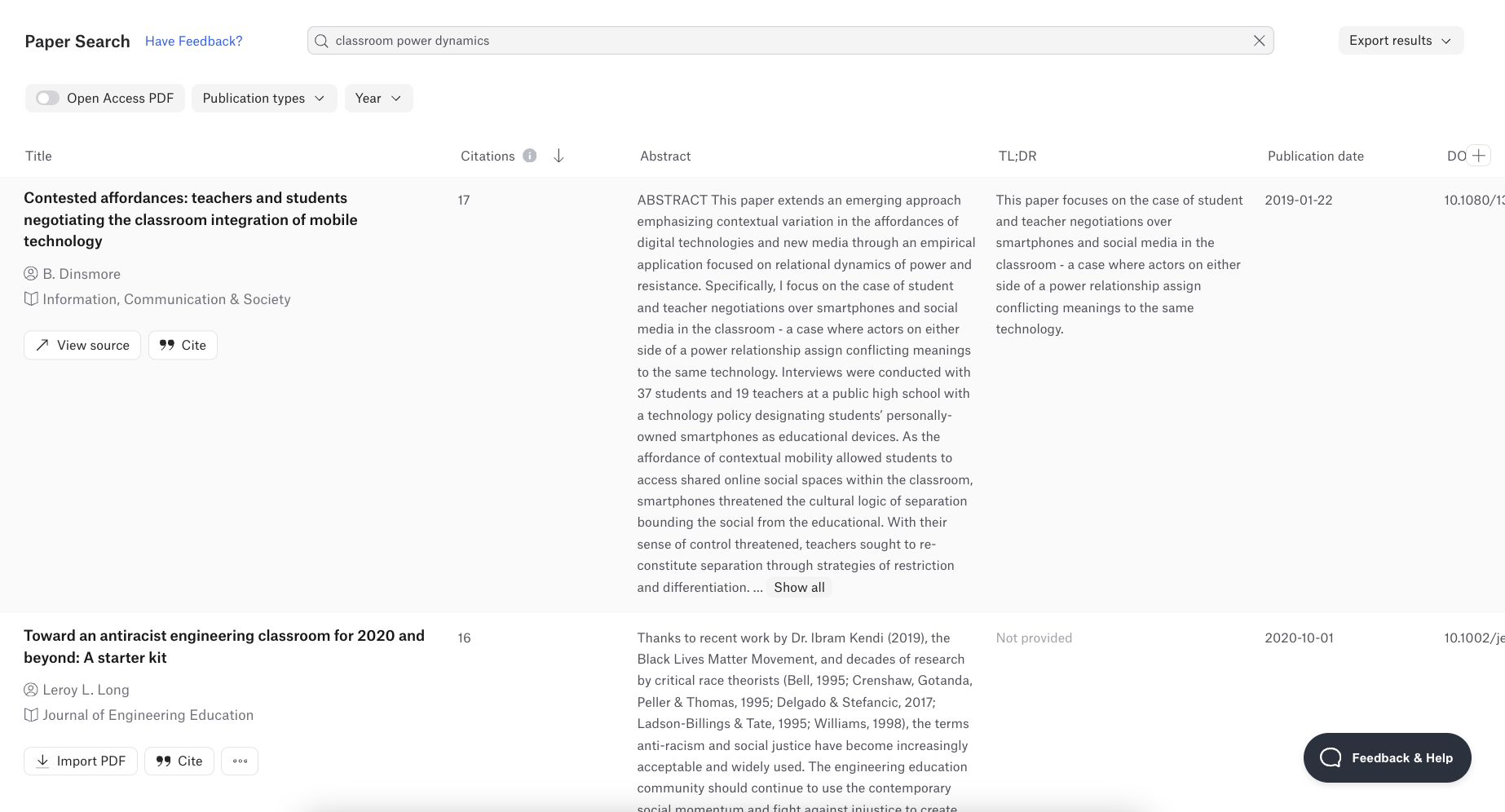
Auto-Coding Tools
Verschiedene Funktionen in ATLAS.ti erleichtern die Automatisierung des Kodierungsprozesses mit größerer Flexibilität als MAXQDA sie bietet. Das Concepts-Tool sucht nach häufig vorkommenden Phrasen, die eine einfache Wortwolke nicht liefern kann, während Opinion Mining eine Sentiment-Analyse dieser Phrasen durchführt, die es den Forschern erlaubt, während des Kodierens positive und negative Stimmungen zu trennen.
Tools wie Focus Group Coding und Named Entity Recognition können den Benutzern helfen, Zeit zu sparen, indem sie automatisch Codes hinzufügen, um anzuzeigen, wer in einem Interview oder einer Fokusgruppe spricht, oder um Personen, Orte und Organisationen zu identifizieren, die in den Daten genannt werden. Die Verwendung dieser Codes in Verbindung mit Codes aus der Stimmungsanalyse und dem Opinion Mining kann dazu beitragen, umfassende Erkenntnisse darüber zu gewinnen, wie die Daten die Diskussion über verschiedene Themen von Interesse in ein positives, negatives oder neutrales Licht rücken.
Die Textsuche ist in ATLAS.ti noch leistungsfähiger und ermöglicht die Suche nach Synonymen und komplexeren Abfragen, um die relevantesten Daten zu erhalten. Die Flexibilität der Textsuche erlaubt es dem Benutzer, eine einzige Suche mit mehreren Schlüsselwörtern zu erstellen, um den Umfang der Daten auf einen bestimmten Satz von Textsegmenten einzugrenzen, die kodiert werden können, unabhängig davon, wo sich die Daten in Ihrem Projekt befinden.
Das Tool "Worthäufigkeiten" ist flexibler als die MAXQDA-Wortwolke, da es Wortteile filtert und Optionen für Stop-and-Go-Listen zur Verfügung stellt, um die Inhaltsanalyse anzupassen. Damit stehen dem Nutzer mehr Möglichkeiten zur Visualisierung seiner qualitativen Daten und Inhaltsanalyse in ATLAS.ti zur Verfügung.
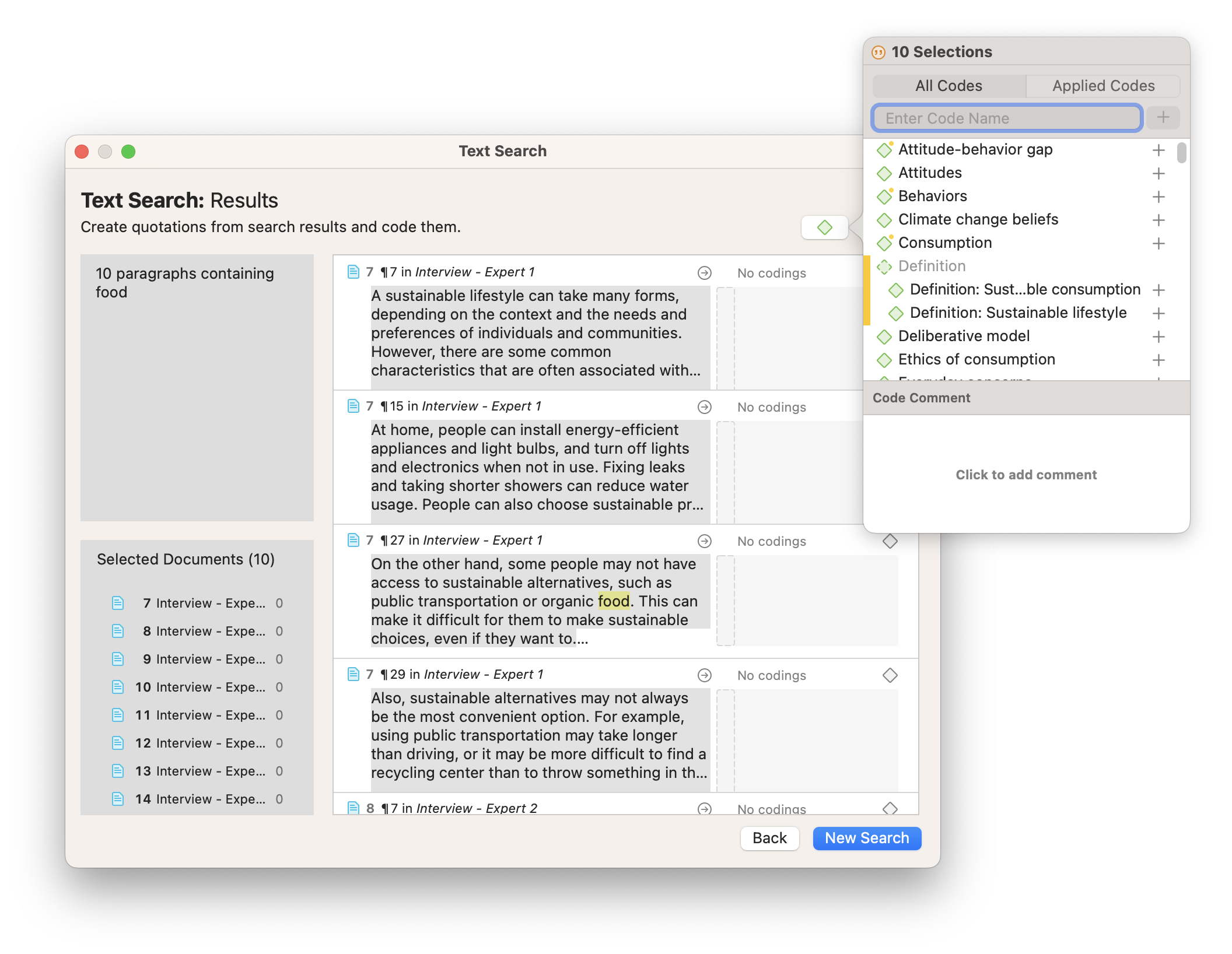
KI-gestützte Datenanalyse
Künstliche Intelligenz spielt auch bei der Kodierung und Analyse von Daten in ATLAS.ti und MAXQDA eine wichtige Rolle. MAXQDA verfügt über eine KI-Hilfsfunktion, um Daten zusammenzufassen und zu erklären, aber seine automatischen Kodierungsmöglichkeiten unterscheiden sich von den KI-gestützten Tools von ATLAS.ti und sind auch begrenzter als diese. So erlaubt ATLAS.ti's Conversational AI den Einsatz eines Chatbots, der Einblicke in mehrere Dokumente in einem Projekt geben kann, während das Äquivalent in MAXQDA nur mit einem Dokument zur gleichen Zeit chatten kann. Die umfassenderen Möglichkeiten von ATLAS.ti sind ideal für die Synthese von Informationen aus mehreren Interviewteilnehmern, Umfragedaten oder anderen Gruppen von Textdokumenten und ermöglichen es den Nutzern, übergreifende Muster und Trends in ihrer Forschungsarbeit zu untersuchen.
ATLAS.ti gibt Ihnen die Flexibilität, den Umfang der Kodierung Ihrer Daten selbst zu bestimmen, egal ob Sie Ihren gesamten Datensatz passend zu Ihrer Forschungsfrage kodiert haben möchten oder ob Sie nur ein wenig Inspiration während des Kodierungsprozesses benötigen. Nutzer von ATLAS.ti können einzelne Datensegmente mit AI Suggested Codes oder ganze Dokumente mit AI Coding oder Intentional AI Coding kodieren, wobei in beiden Fällen eine Kodierstruktur mit Kategoriecodes und Subcodes erstellt wird, um die Kodes übersichtlich zu halten. Im Gegensatz dazu können die KI-Funktionen von MAXQDA nur ein Datensegment auf einmal kodieren, nicht aber ganze Dokumente, und sie können nur Untercodes von bereits vorhandenen Codes vorschlagen.
KI-gestützte Tools beider Plattformen können die allgemeine Bedeutung Ihrer Textdaten kodieren, aber nur ATLAS.ti's Intentional AI Coding erlaubt es dem Nutzer, die KI anzuweisen, die Daten auf der Basis spezifischer Forschungsfragen zu kodieren. Intentional AI Coding von ATLAS.ti bietet eine reichhaltige Kodierungsstruktur, die eine transparente Analyse erleichtert. Forscher können jederzeit auf jedes Zitat doppelklicken, um es in seinem ursprünglichen Kontext zu sehen, was es ihnen ermöglicht, die "Black Box" der künstlichen Intelligenz zu öffnen und das gesamte Bild ihrer Daten zu sehen.
ATLAS.ti's Intentional AI Coding erzeugt Kodierungsstrukturen, die auf Ihre Forschungsfragen zugeschnitten sind, mit Kategorie-Codes und Sub-Codes, die für Ihre Datenanalyse relevant sind. Wichtig ist, dass der Forscher der KI mitteilen kann, wie sie seine Daten kodieren soll, einschließlich der Angabe von Leitfragen und relevanten Codes. Kein anderes CAQDAS bietet Forschern dieses Maß an Kontrolle darüber, wie KI-gesteuerte Tools die Daten automatisch kodieren sollen.

Natürlich empfehlen wir den Forschern, die von der künstlichen Intelligenz gelieferten Ergebnisse immer zu überprüfen, aber die Zeitersparnis zwischen der manuellen Kodierung und der Kodierung mit KI-gestützten Werkzeugen wird sich zweifellos auf den Forschungsprozess auswirken.
Am wichtigsten ist, dass ATLAS.ti-Nutzer unbegrenzten Zugang zu unseren KI-Tools haben, unabhängig von der Größe ihres Datensatzes. MAXQDA-Nutzer können die KI-Tools nur für eine begrenzte Anzahl von Daten pro Tag nutzen, bevor sie für zusätzliche Nutzung bezahlen müssen. Das kann problematisch sein, wenn man große Datenmengen durchforsten muss.
Eine Volllizenz für ATLAS.ti hingegen hat keine Einschränkungen bei der Nutzung von KI-Tools, einschließlich KI-Vorschlägen, KI-Codierung und absichtlicher KI-Codierung. Das bedeutet, dass - anders als bei MAXQDA - Projekte jeder Größe die Vorteile der künstlichen Intelligenz in ATLAS.ti nutzen können, ohne dass zusätzliche Kosten anfallen.
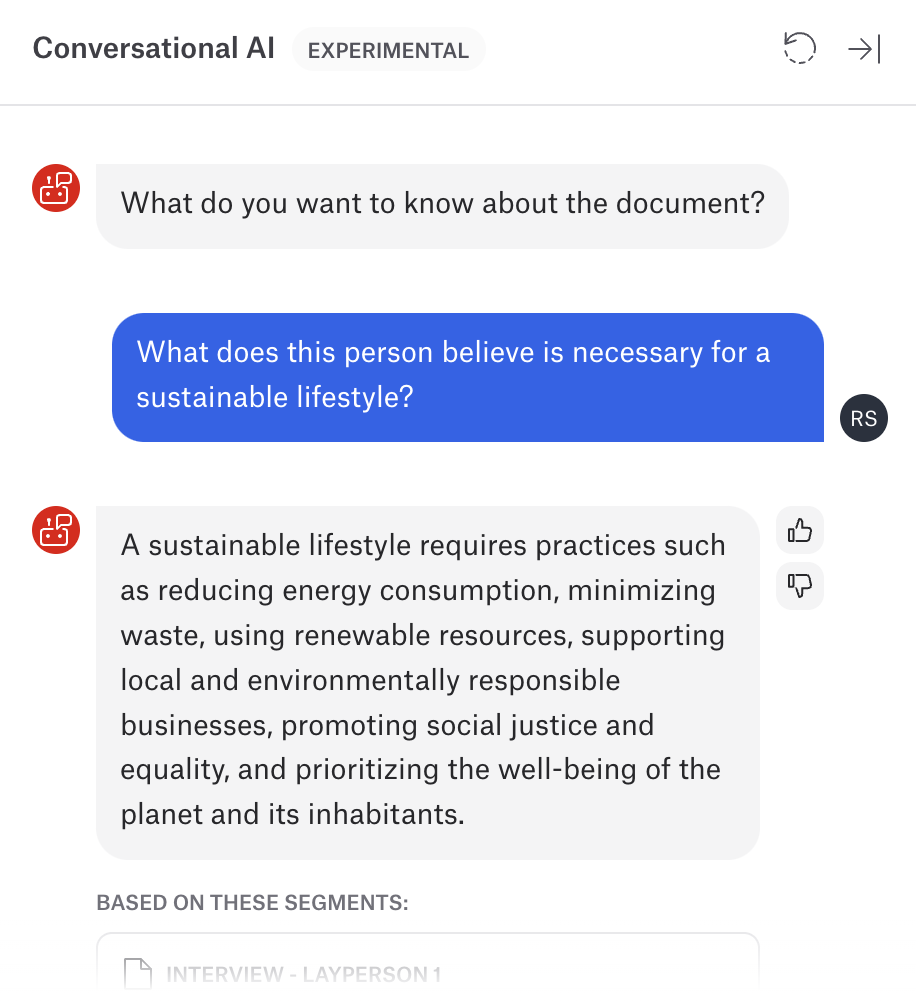
Datenanalyse
Mit dem Query Tool lassen sich leichte Muster in den Daten finden, unabhängig davon, in welchem Dokument die Erkenntnisse zu finden sind. In einem einzigen Interface können ATLAS.ti-Anwender detaillierte Abfragen ihrer kodierten Daten konstruieren, die in MAXQDA mehrere Tools erfordern würden. Anstatt mehrere sequenzielle Analysen in MAXQDA's Code Explorer oder Complex Coding Query durchzuführen, kann ATLAS.ti's Query Tool mehrere Kriterien für Codes mit jeder beliebigen Kombination von Booleschen und Proximity-Operatoren berücksichtigen, die zu Ihrer Forschungsanfrage passen.

Die Analyse von Daten ist auch mit anderen Tools wie der Code Co-Occurrence Analysis und der Code-Document Analysis einfach, wobei nützliche Visualisierungen von Code-Code- und Code-Document-Beziehungen in ATLAS.ti schneller erstellt werden können als mit den entsprechenden MAXQDA-Features. Beide Tools in ATLAS.ti haben eine einfache Oberfläche, die es dem Benutzer erlaubt, schnell Tabellen zu erstellen, um potentielle Beziehungen zwischen Codes bzw. zwischen Codes und Dokumenten zu analysieren. Während der Benutzer in MAXQDA durch komplizierte Dialogboxen für die Analysetools navigieren muss, lassen sich viele Schlüsselanalysen in ATLAS.ti durch einfache Auswahl von Codes und/oder Dokumenten zur Kreuzanalyse in einer Tabelle erstellen. Darüber hinaus ist es in ATLAS.ti einfacher, die Daten, die die Analyse unterstützen, in einem eleganten Interface zu betrachten, in dem Tabellen, Abbildungen und relevante Zitate im selben Fenster angezeigt werden, anstatt jeden Teil der Analyse in separaten Tools mit eigenen Setup-Prozessen und mehreren Fenstern aufzuteilen, die Ihren Bildschirm und Ihre Analyse unübersichtlich machen können.
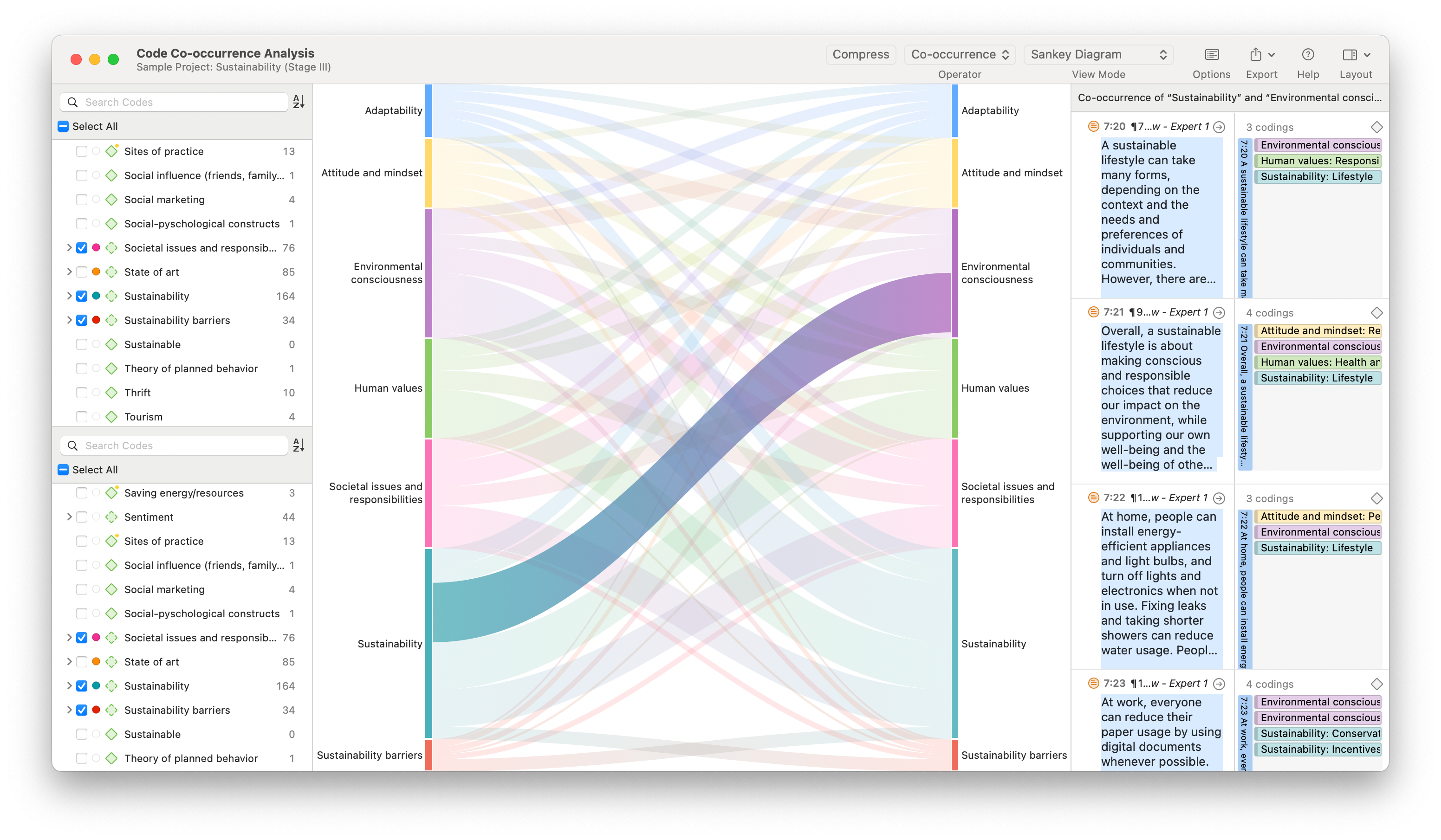
Visualisierungen
Einmal erstellte Tabellen aus Code Co-Occurrence Analaysis und Code-Document Analysis können für Visualisierungen in Form von Force-Directed Graphen und Sankey-Diagrammen verwendet werden, Visualisierungen, die nur in ATLAS.ti verfügbar sind.
Der Network View in ATLAS.ti bietet Forschern Werkzeuge zur Erstellung anschaulicher konzeptioneller Karten und tiefgehender Visualisierungen ihrer Daten. Verknüpfungen zwischen verschiedenen Codes, Zitaten, Memos, Gruppen und Dokumenten können in einer Theorievisualisierung dargestellt werden, die eine reichhaltige qualitative Analyse der Daten des Projekts widerspiegelt. Anders als in MAXQDA, wo das Äquivalent des Network View nur eine einfache Reihe von Visualisierungsmöglichkeiten bietet, kann der Benutzer Links in einem ATLAS.ti-Netzwerk durch die Art der Beziehung zwischen Codes definieren, um seine Theorie zu entwickeln und Erkenntnisse vorzuschlagen.
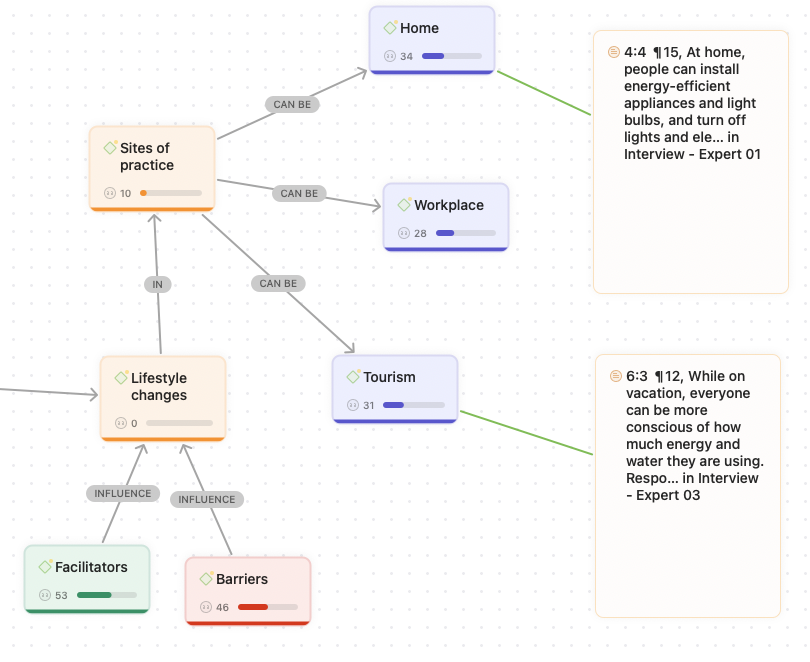
Ein vollständig kodiertes Projekt in ATLAS.ti kann qualitativ analysiert werden, wie z.B. in Networks zur Visualisierung von Theorien, die sich aus Ihrer Kodierstruktur ergeben, oder quantitativ, wie z.B. in der Treemap-Ansicht, die die am häufigsten auftretenden Codes und Themen visualisiert. Das voll integrierte Kodiersystem in ATLAS.ti berücksichtigt alle Arten von Forschungsparadigmen in einer zugänglichen und benutzerfreundlichen Weise. Mit automatischen Layout-Optionen, editierbaren Links zur Definition der Beziehungen in Ihrer Theorie und vollständiger Integration mit dem Rest Ihres Projekts können Sie Netzwerke zur Visualisierung Ihrer Theorie und zur Steuerung weiterer Analysen nutzen.
Weitere Visualisierungen wie Sankey-Diagramme, Force-Directed-Graphs und Treemaps stehen in ATLAS.ti zur Verfügung, um Ihre Forschung auf vielfältige Weise zu visualisieren. ATLAS.ti kann Forschern helfen, ihre qualitativen Daten in aufschlussreiche Illustrationen von Code-Verteilungen, Themen und vielem mehr zu verwandeln, um das Publikum mit informativen und ansprechenden Visualisierungen zu überzeugen.
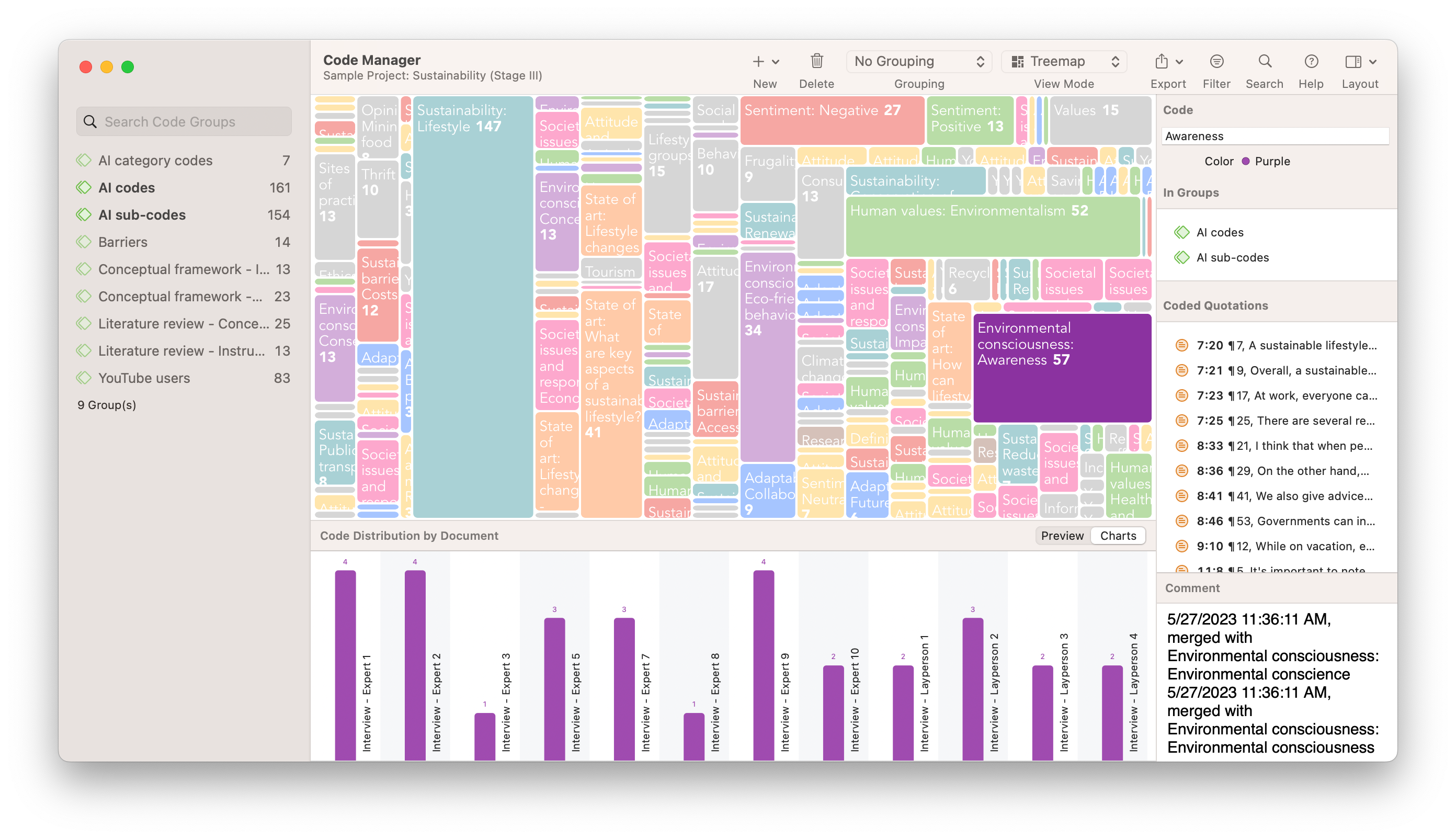
Forschungsnotizen in Memos
Ein Bereich, in dem sich ATLAS.ti von MAXQDA abhebt, sind die Tools, die die Entwicklung theoretischer Erkenntnisse erleichtern. Dies ist zweifellos eine der Aufgaben, die ein Forscher nicht automatisieren oder an künstliche Intelligenz delegieren kann, aber QDA-Software kann diese Aufgabe einfacher und aufschlussreicher machen.
Ein Raum für Forschungsmemos ist in ATLAS.ti integriert, der es ermöglicht, nützliche Notizen, Reflexionen und Einsichten über potentielle theoretische Entwicklungen zu notieren, wenn sich Erkenntnisse ergeben. ATLAS.ti-Memos sind intuitiv bedienbar und können mit Zitaten, Dokumenten, Codes und Gruppen verknüpft werden, um eine organisierte Referenz zu ermöglichen. Anders als in MAXQDA können Zitate in ATLAS.ti direkt in Memos eingefügt werden, um eine nahtlose und integrierte Analyse zu ermöglichen, die Schlüsseldaten mit kritischen Überlegungen verbindet.
Die Komplexität des MAXQDA-Memosystems mit seinen verschiedenen Memo-Typen kann sich für Forscher als einschränkend erweisen, wenn sich ihre Notizen auf verschiedene Einheiten in ihrem Projekt beziehen. ATLAS.ti hingegen erlaubt es den Forschern, eigenständige Memos zu erstellen oder diese Memos ohne Einschränkungen mit jedem Teil ihrer Forschung zu verknüpfen, was eine größere Flexibilität bei der Anpassung eines Projekts an jede Forschungsfrage bietet.
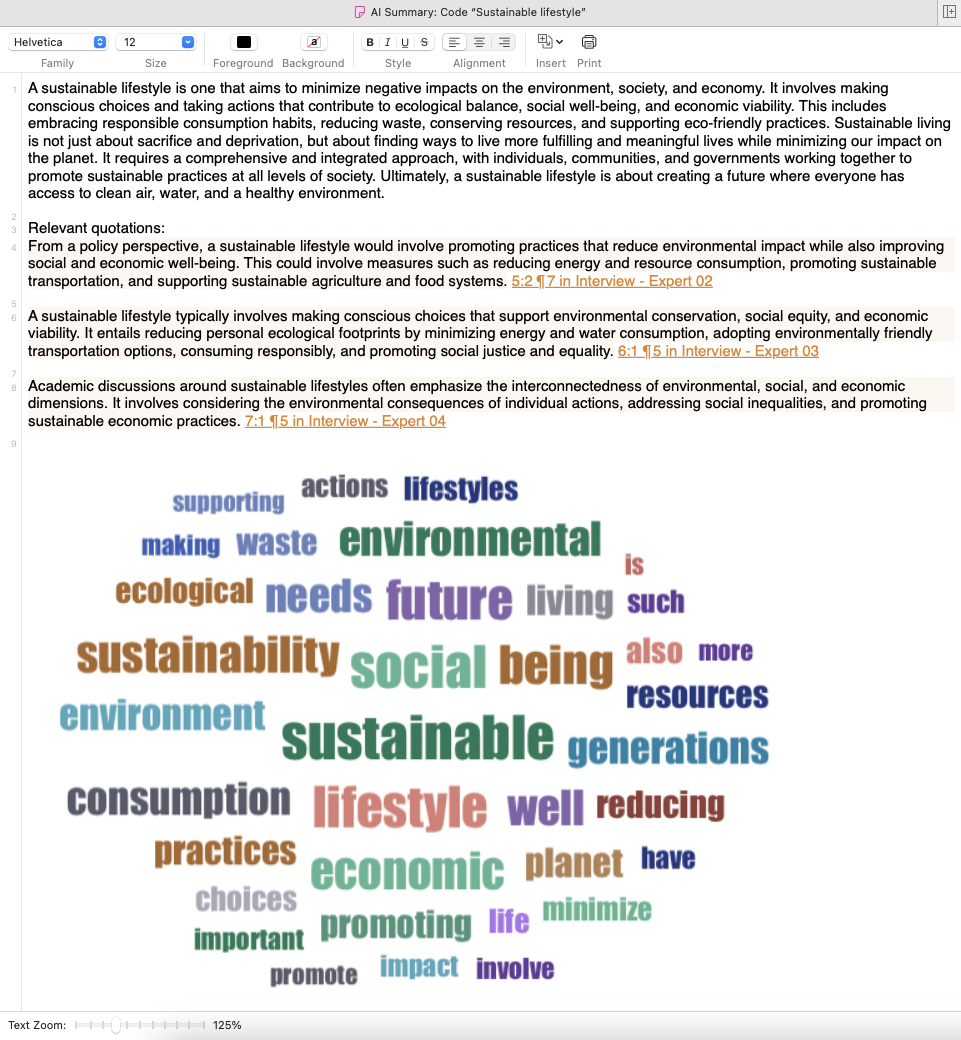
Schnittstelle und Benutzerfreundlichkeit
ATLAS.ti ist so konzipiert, dass die Lernkurve, die für die qualitative Datenanalyse erforderlich ist, so einfach wie möglich ist. Organisation und Kodierung sind in ATLAS.ti einfacher und bieten dennoch die Möglichkeit, kritische Erkenntnisse aus qualitativen Daten zu gewinnen. Das bedeutet, dass Sie weniger Zeit für die mühsamen Aufgaben der qualitativen Forschung aufwenden müssen und mehr Zeit für aussagekräftige Analysen haben, die für Sie und Ihr Forschungspublikum zugänglich sind.
ATLAS.ti hat eine übersichtliche Oberfläche mit einer klaren Organisation der Funktionen und Möglichkeiten. Projekteinheiten wie Dokumente und Codes sind klar abgegrenzt, während die wichtigsten Analysewerkzeuge an einer Stelle angeordnet sind (entweder im Analyse-Menü unter Mac oder im Analyse-Tab unter Windows), um den Zugriff zu erleichtern.
Darüber hinaus erlaubt es die Oberfläche, die Recherche in einem einzigen Fenster zu organisieren und zwischen mehreren Registerkarten zu wechseln, um die Recherche aus verschiedenen Blickwinkeln zu betrachten. MAXQDA bietet nur die Möglichkeit, Dokumentfenster vom Hauptbildschirm abzudocken, was ohne die nötige Übersichtlichkeit schnell unübersichtlich werden kann.
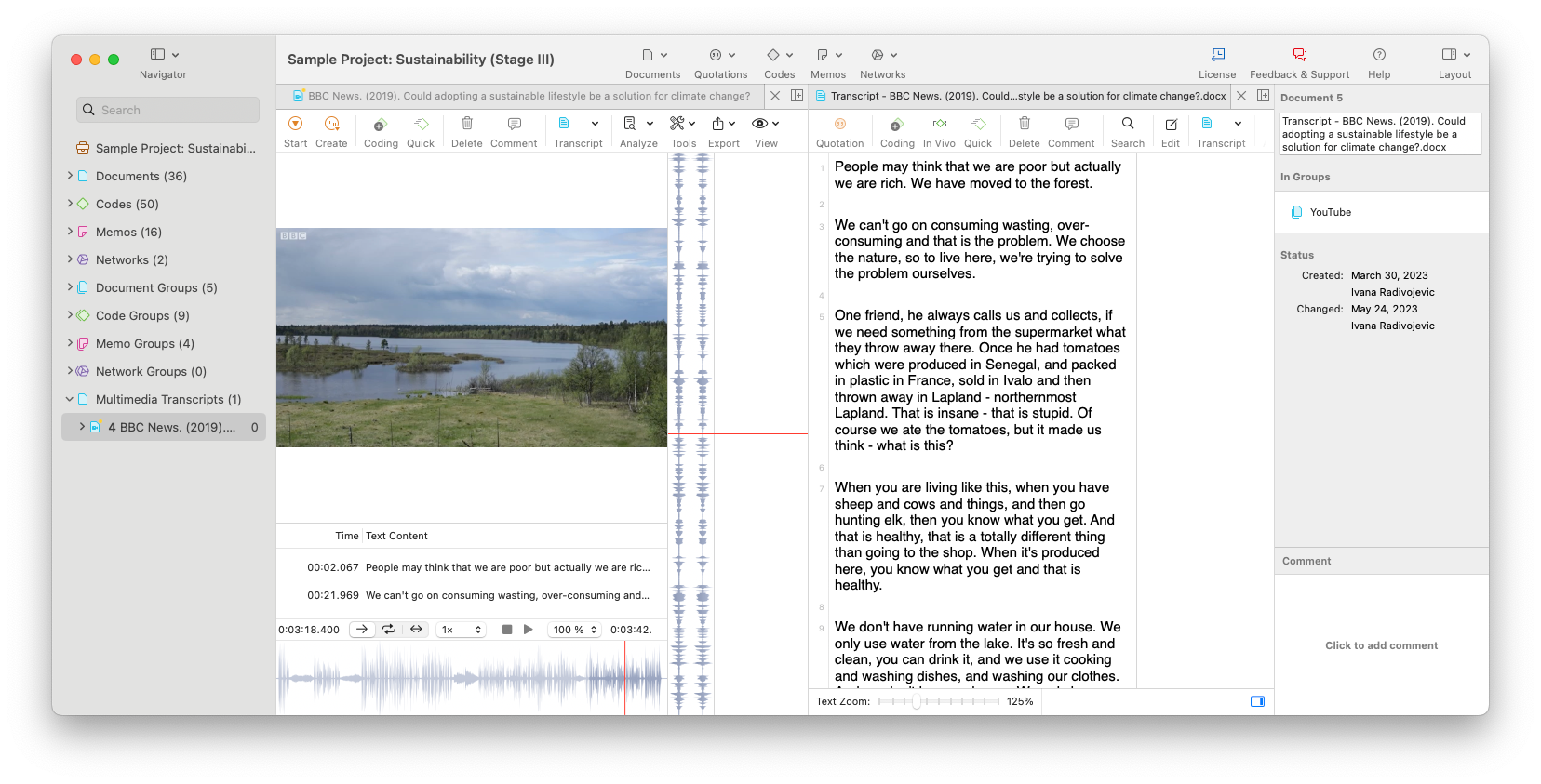
Organisation von Daten
Gründliche Forschungsprojekte jeder Größe erfordern zweifellos eine Organisation, um die Datenanalyse zu erleichtern. Selbst Forscher mit kleinen Forschungsprojekten können sich in den mühsamen Aufgaben der Kategorisierung von Dokumenten nach verschiedenen Datentypen, Datenerfassungsmethoden, Forschungsstandorten und sogar demografischen Daten der Forschungsteilnehmer verzetteln.
So mühsam diese Herausforderung auch ist, die Organisation innerhalb eines gesamten Projekts ist notwendig, denn je mehr Organisation die QDA-Plattform bieten kann, desto reichhaltiger ist die Analyse. Creswell und Poth (2018) weisen beim Vergleich von ATLAS.ti, MAXQDA, NVivo und HyperRESEARCH auf die Fähigkeit von ATLAS.ti hin, Daten schnell zu suchen und zu finden, was für eine einfache und für die Nutzer zugängliche Datenanalyse unerlässlich ist.
ATLAS.ti zeichnet sich durch einen intuitiven Document Manager aus, der es erlaubt, Dokumente nach verschiedenen Kategorien zu sortieren, die durch Dokumentengruppen repräsentiert werden. Dokumentengruppen bieten eine Flexibilität, die in MAXQDA nicht gegeben ist. MAXQDA bietet ein traditionelles Dateisystem für Dokumente, das die Organisation von Daten einschränken kann, wenn Ihre Dokumente gleichzeitig zu mehreren Kategorien oder Analysen gehören.
In ATLAS.ti schließen sich Dokumentengruppen nicht gegenseitig aus, d.h. Sie können Ihre Daten je nach Fragestellung in beliebig viele analytische oder organisatorische Kategorien einteilen, was die Analyse Ihrer Daten aus verschiedenen Blickwinkeln erleichtert. Dies ist nützlich, wenn Sie z.B. die Daten der Befragten nach Geschlecht, Alter, ethnischer Zugehörigkeit, Einkommensniveau oder einer anderen für Ihre Untersuchung nützlichen Kategorie sortieren wollen.
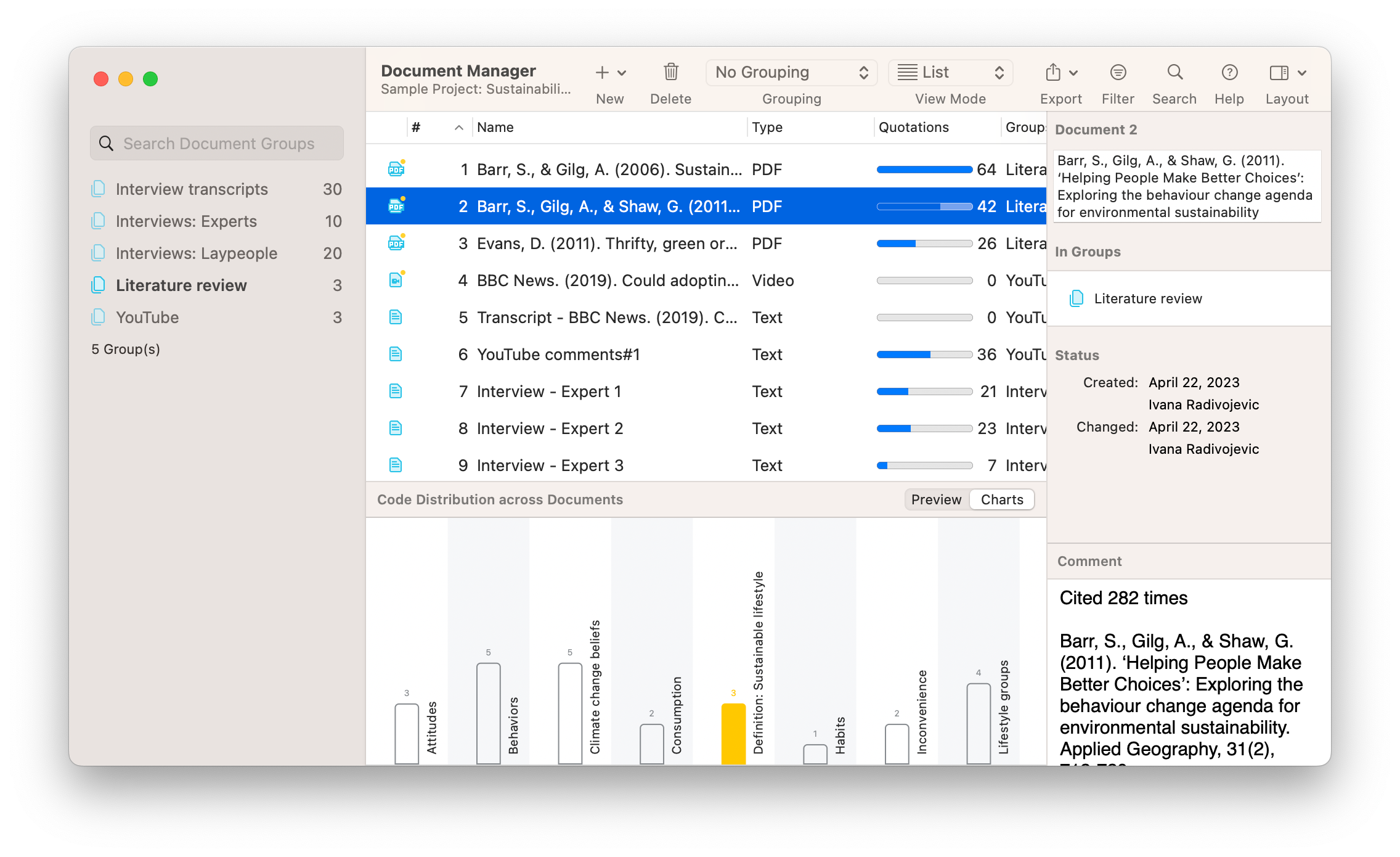
Zusammenarbeit mit Teammitgliedern
Teamarbeit in qualitativen Forschungsprojekten erfordert eine QDA-Plattform, die eine einfache Integration der Projektarbeit gewährleistet. Sowohl ATLAS.ti als auch MAXQDA verfügen über Werkzeuge, die dabei helfen, die Arbeit der Codierer in einem kollaborativen Forschungsprojekt zu organisieren und die Intercoder-Übereinstimmung zu berechnen.
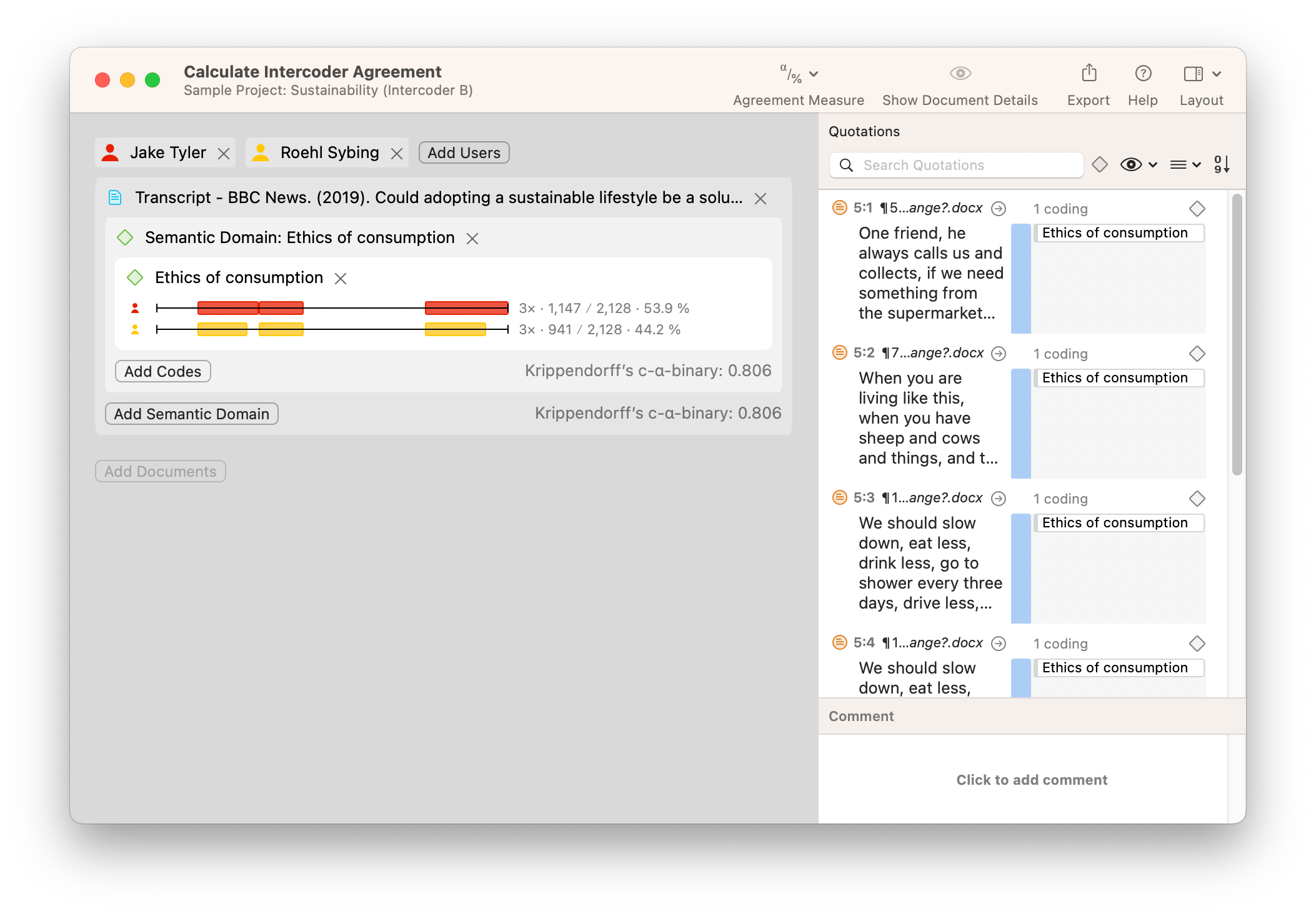
ATLAS.ti bietet jedoch verschiedene Funktionen, die die gemeinsame Nutzung von Projekten durch Teammitglieder erleichtern, wie z.B. die Echtzeit-Zusammenarbeit in ATLAS.ti Web für teambasiertes Coding. ATLAS.ti ist die einzige QDA-Software, die vollen Zugang zu allen Plattformen bietet, einschließlich des Online-ATLAS.ti Web, was den Forschern ultimative Flexibilität bei der Entscheidung gibt, wo und wie sie mit anderen zusammenarbeiten wollen.
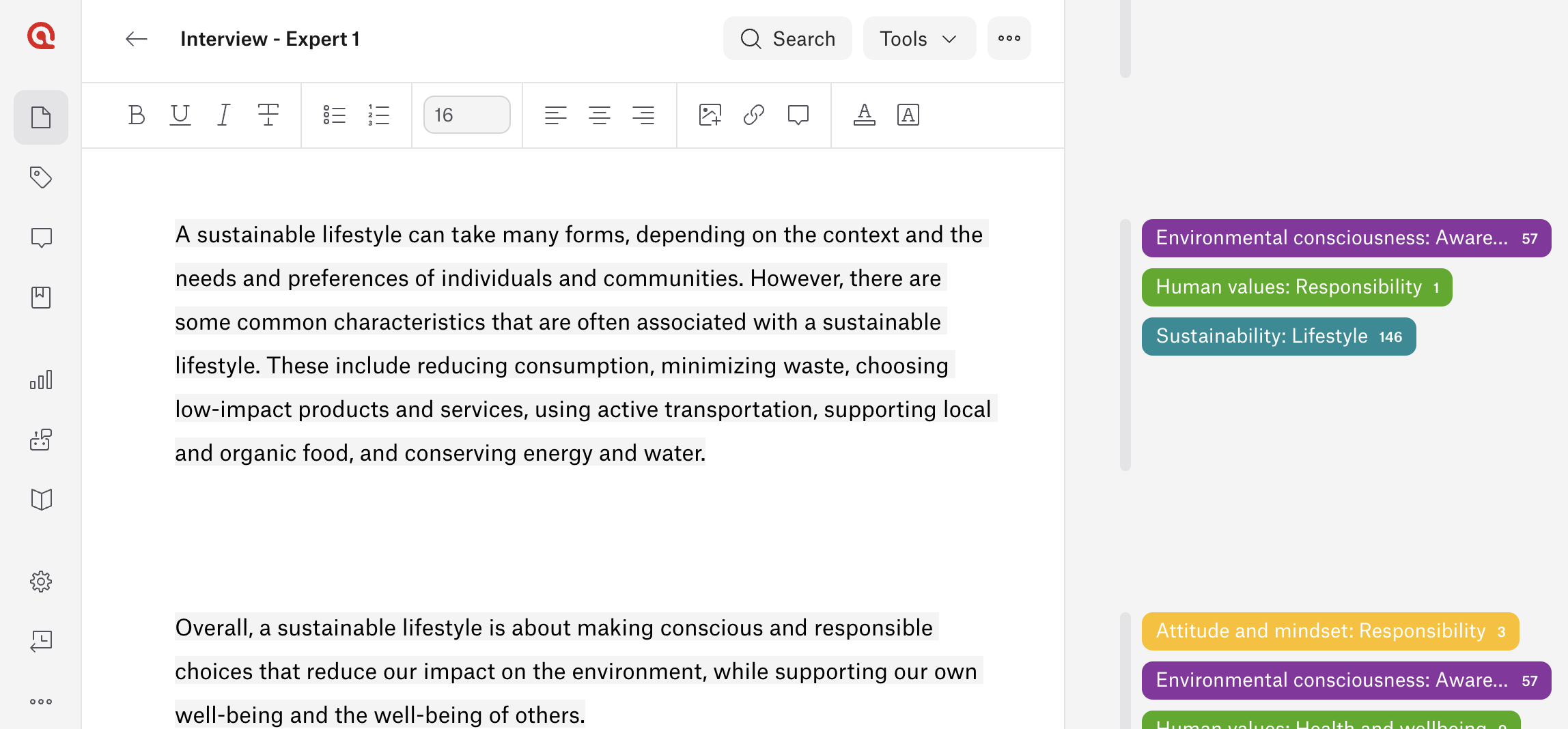
Cloud-Speicher für gemeinsame Projekte
ATLAS.ti Desktop ermöglicht auch die Zusammenarbeit zwischen Anwendern durch asynchrone Projektspeicherung. ATLAS.ti-Anwender können ihre Projekte in unserem Cloud-Speicher ablegen und sie mühelos mit anderen Anwendern teilen, die ihre Projekte dann auf ihre eigenen Geräte herunterladen und die Arbeit an der Codierung und Analyse fortsetzen können.
Während MAXQDA den Team-Zugang zu Projekten auf bis zu fünf Nutzer beschränkt, gibt es bei ATLAS.ti keine Beschränkungen, d.h. alle ATLAS.ti-Nutzer können sich an einem Projekt beteiligen, unabhängig davon, welche Art von Lizenz jeder einzelne hat oder wo auf der Welt er sich befindet. Dies ermöglicht es Forschern verschiedener Institutionen und Länder, ohne Einschränkung an demselben Forschungsprojekt zu arbeiten.
Kompatible Datentypen
Die Plattform von ATLAS.ti kann auch eine größere Vielfalt an qualitativen Daten aufnehmen als MAXQDA. Da sich die Bedürfnisse qualitativer Forscher im Laufe der Jahre weiterentwickelt haben, umfasst der typische Projekt-Workflow verschiedene Formen von Daten, darunter PDF-Dateien, Multimedia-Dateien für Bilder, Audio und Video sowie Dateien mit geografischen Daten. Vertiefende Forschungsprojekte stützen sich auf verschiedene Formen von Daten, die alle in ein ATLAS.ti-Projekt eingebunden werden können.
Sowohl ATLAS.ti als auch MAXQDA sind in der Lage, gängige Dateiformate wie Textdateien, GIF-Dateien und PDF-Dateien zu lesen. ATLAS.ti ist jedoch auch mit anderen Dateitypen kompatibel, wie z.B. BMP-Dateien für Bilder, MOBI-Dateien für eBooks und Dokumente mit geographischen Daten. Die breitere Palette der in ATLAS.ti kompatiblen Dateiformate kommt mehr Forschern in mehr Forschungsbereichen zugute.
Auch die Recherche in sozialen Medien ist in ATLAS.ti flexibler. MAXQDA erlaubt nur den Import von Tweets aus Twitter/X, was Forscher, die Trends in sozialen Medien analysieren wollen, einschränkt. Andererseits können Forscher Daten von jedem beliebigen Social Media-Post, wie z.B. Kommentare von YouTube-Videos, TikTok-Posts, Instagram-Posts und mehr in jedes ATLAS.ti-Projekt importieren.
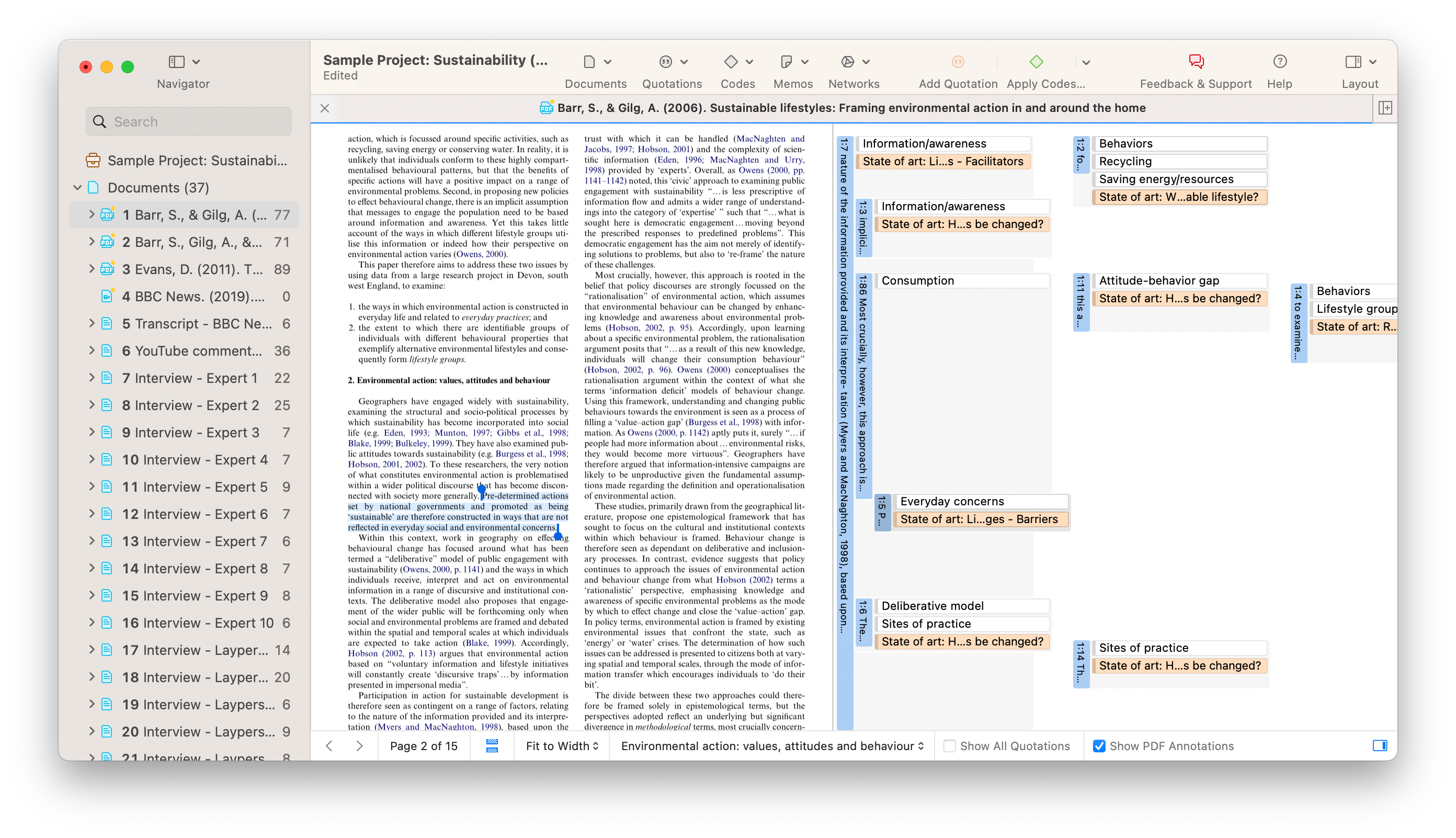
ATLAS.ti-Anwender genießen ein höheres Maß an Flexibilität im Umgang mit PDF-Dateien. Kommentare in PDF-Dateien bleiben als Zitate erhalten, was für Literaturübersichten und die reibungslose Übernahme erster qualitativer Analysen aus Roh-PDFs direkt in ATLAS.ti nützlich sein kann.
Umfassendes Support-System
Die Unterschiede zwischen ATLAS.ti und MAXQDA beschränken sich nicht nur auf die Software-Plattform. ATLAS.ti hat viel Zeit und Mühe darauf verwandt, ein ganzes Ökosystem um die Plattform herum aufzubauen, um qualitative Forscher in allen Phasen des Forschungsprozesses zu unterstützen.
Der Erwerb von Lizenzen und die Benutzerverwaltung sind mit ATLAS.ti einfach. Es gibt keine versteckten Kosten oder Gebühren für Extra-Features; anders als bei MAXQDA berechtigt eine Desktop+Web-Lizenz zu einer voll funktionsfähigen QDA-Plattform in ATLAS.ti ohne Einschränkungen, unabhängig von Größe und Umfang des Forschungsprojekts. Darüber hinaus können ATLAS.ti-Mehrfachlizenzen von beliebig vielen Personen überall auf der Welt genutzt werden, ohne Einschränkungen hinsichtlich der Anzahl der Software-Installationen, der Geräte, die ATLAS.ti nutzen können, oder des Zugangs zu Windows-, Mac- oder Web-Plattformen.
Mit anderen Worten: Eine ATLAS.ti-Mehrbenutzerlizenz bietet ultimative Flexibilität, so dass Lizenzadministratoren den Zugang mit anderen Personen teilen und die Lizenzbenutzer einfach in ihrem persönlichen ATLAS.ti-Admin-Account verwalten können. Das Lizenzmanagement-System gibt automatisch einen Platz in der Lizenz frei, sobald sich eine Person aus ihrer Sitzung abmeldet, so dass jeder andere diesen Platz einnehmen kann, wenn er sich in ATLAS.ti Windows, Mac oder Web einloggt.
ATLAS.ti verfügt über eine ganze Reihe von Online-Trainings und schriftlichen Ressourcen, die den Nutzer in die qualitative Forschungsmethodik und die ATLAS.ti-Plattform einführen. Alle diese von ATLAS.ti-Experten verfassten Ressourcen wurden mit dem Ziel erstellt, den Nutzern mehr Kompetenz in der qualitativen Forschung zu vermitteln.
ATLAS.ti-Anwender haben kostenlosen Zugang zu einem Expertenteam, das 24 Stunden am Tag, 5 Tage die Woche technische und methodische Fragen beantwortet. Über E-Mail, Telefon und Live-Chat können ATLAS.ti-Anwender einen Support in Anspruch nehmen, der bei anderen QDA-Plattformen nicht verfügbar ist.
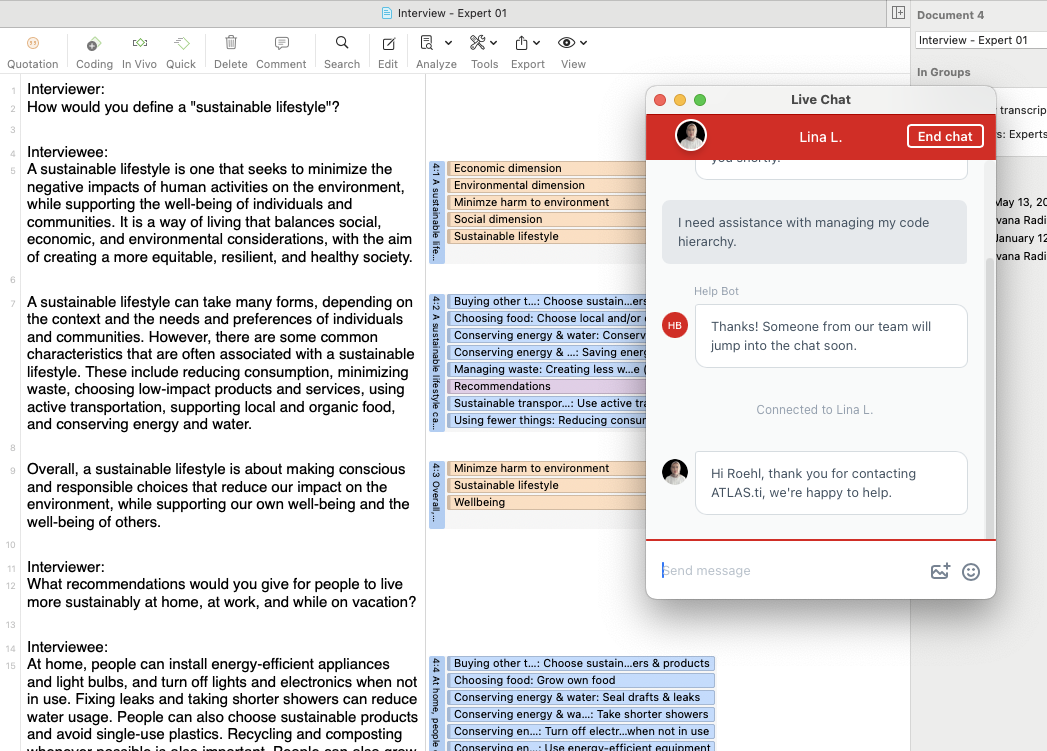
Allgemeine Vorteile
Während ATLAS.ti und MAXQDA qualitative Forscher in allen Kernaspekten der Datenorganisation und -analyse unterstützen, bietet ATLAS.ti eine Reihe von Vorteilen, die den Forschungsprozess insgesamt einfacher und aufschlussreicher machen.
Benutzerfreundliches Interface
ATLAS.ti wird von den Anwendern wegen seiner intuitiven und benutzerfreundlichen Oberfläche genutzt. Die Plattform ist darauf ausgelegt, den Forschungsprozess so einfach wie möglich zu gestalten, so dass Forscher die Funktionalitäten schnell erfassen und sich mehr auf die Datenanalyse als auf die Software-Navigation konzentrieren können. Mit seinem übersichtlichen Layout bietet ATLAS.ti eine klare Abgrenzung von Projekteinheiten wie Dokumenten, Codes und Memos und erleichtert so die effiziente Verwaltung und Analyse von Daten.
Im Gegensatz zur MAXQDA-Oberfläche, die durch abgedockte Fenster schnell unübersichtlich werden kann, sorgt ATLAS.ti mit seiner Ein-Fenster-Oberfläche mit mehreren Tabs für einen optimierten Arbeitsablauf. Diese Benutzerfreundlichkeit erlaubt es den Forschern, sich mehr Zeit für die Gewinnung wichtiger Erkenntnisse aus ihren qualitativen Daten zu nehmen.
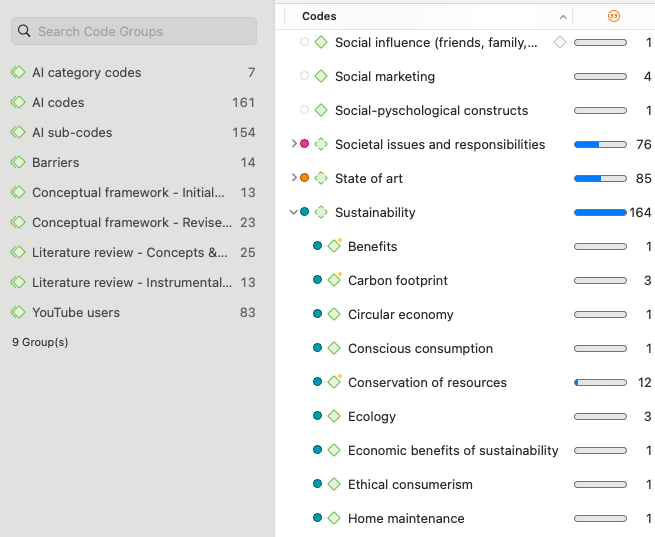
Umgang mit qualitativen Daten
ATLAS.ti bietet eine hohe Flexibilität im Umgang mit Daten, da es ein breiteres Spektrum an Dateitypen und Datenformaten als MAXQDA unterstützt. Egal, ob es sich um Textdateien, PDFs, Multimediadateien oder sogar geografische Daten handelt, ATLAS.ti integriert diese unterschiedlichen Datenquellen nahtlos in ein zusammenhängendes Projekt. Forscher können auch Daten von verschiedenen Social-Media-Plattformen importieren und sind nicht wie in MAXQDA auf Twitter/X beschränkt.
Die Fähigkeit von ATLAS.ti, PDF-Kommentare als Zitate zu speichern, verbessert den Prozess der Literaturrecherche und erleichtert es, erste qualitative Analysen direkt in die Plattform zu übertragen. Diese weitreichende Kompatibilität stellt sicher, dass Forscher alle relevanten Daten in ihre Analyse einbeziehen können und so ein umfassenderes Verständnis ihres Forschungsthemas erhalten.
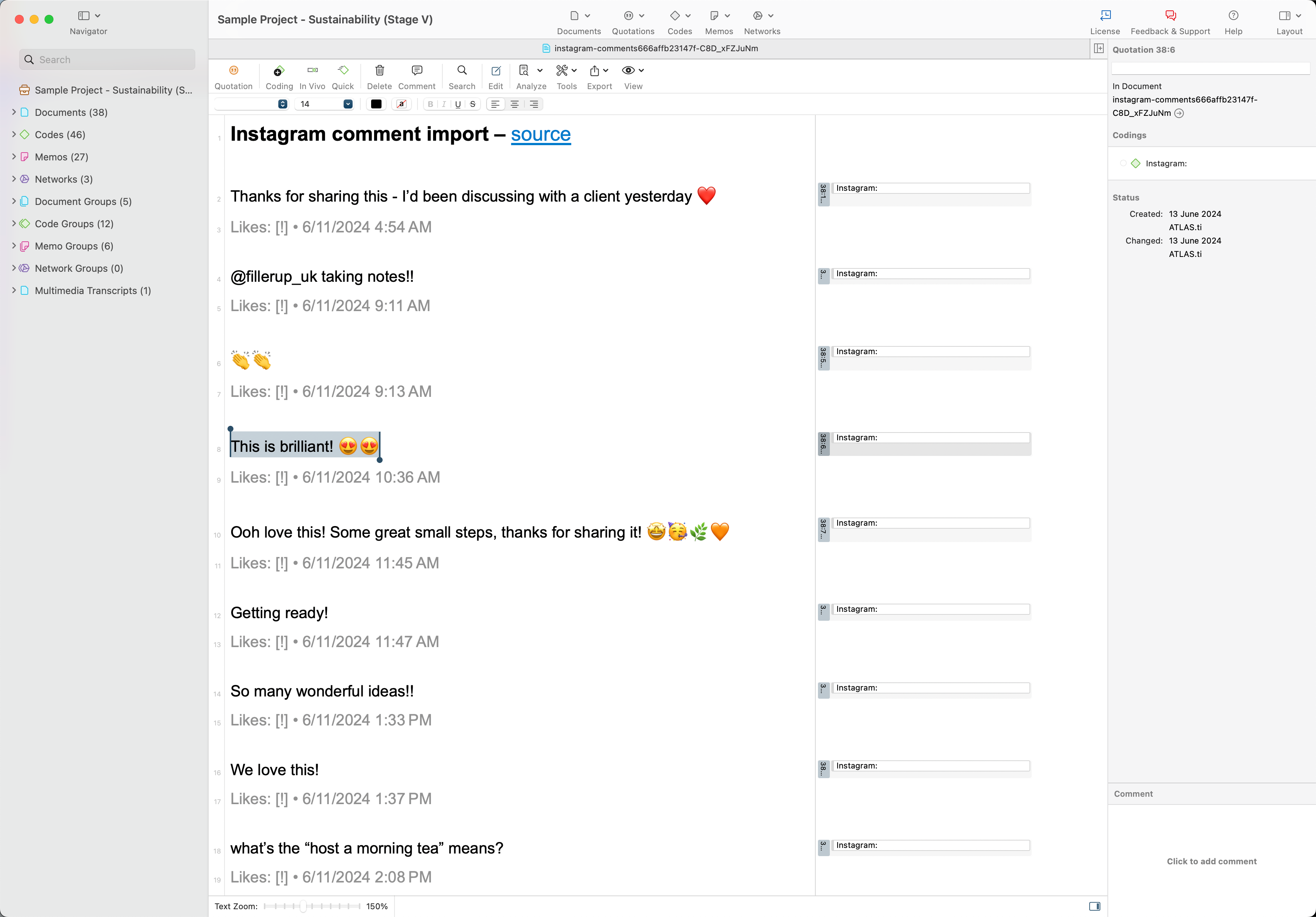
Einfache und mühelose Kollaboration
ATLAS.ti erleichtert die Zusammenarbeit im Forschungsteam durch Tools, die Echtzeit- und asynchrone Teamarbeit ermöglichen. Mit dem Echtzeit-Kollaborations-Feature von ATLAS.ti Web können mehrere Programmierer gleichzeitig an einem Projekt arbeiten, was eine konsistente Kodierung und einen Konsens zwischen den Teammitgliedern gewährleistet. Im Gegensatz dazu beschränkt MAXQDA den Team-Zugang zu Projekten auf bis zu fünf Benutzer, was große, institutionenübergreifende Forschungsprojekte behindern kann.
Darüber hinaus bietet ATLAS.ti einen Cloud-Speicher für die einfache gemeinsame Nutzung und Zusammenarbeit von Projekten ohne Beschränkungen hinsichtlich der Anzahl der Nutzer oder Lizenzen. Diese robuste Kollaborationsfunktion ermöglicht es Forschern von verschiedenen Standorten und Institutionen, nahtlos zusammenzuarbeiten, was den gesamten Forschungsprozess verbessert und eine umfassendere und genauere Datenanalyse gewährleistet.
Lizenzierungsoptionen
ATLAS.ti bietet transparente Lizenzierungsoptionen ohne versteckte Gebühren, die es Einzelpersonen und Organisationen ermöglichen, die Möglichkeiten der Software ohne unerwartete finanzielle Belastungen voll auszuschöpfen. Die Software ist auf mehreren Plattformen erhältlich, darunter Desktop- und Online-Versionen. Jede Version von ATLAS.ti ist nativ für das jeweilige Betriebssystem konzipiert, um optimale Funktionalität und Leistung zu gewährleisten. Forscher können ihre Projekte nahtlos zwischen ATLAS.ti Desktop und Web verschieben und genießen 100%ige Kompatibilität zwischen ATLAS.ti Windows und Mac. Diese Flexibilität ermöglicht es Forschern, effizient im Büro, zu Hause oder im Feld zu arbeiten, und erlaubt Teams eine reibungslose Zusammenarbeit, auch wenn sie eine Mischung aus Windows- und Mac-Computern verwenden. Diese umfassende Zugänglichkeit unterstützt eine dynamische Forschungsumgebung und kommt den Mobilitätsbedürfnissen des modernen Forschers entgegen.
Leistungsfähigere AI-Tools
ATLAS.ti bietet unvergleichliche Fähigkeiten im Bereich der künstlichen Intelligenz, die in anderen QDA-Plattformen nicht zu finden sind, und eignet sich damit für Forscher aller Fachrichtungen und Vorlieben. Dank der Flexibilität der verschiedenen KI-gestützten Tools in ATLAS.ti können Nutzer einen Teil oder einen Großteil ihrer Daten mit KI kodieren, was durch die Möglichkeit, den Kodierungsprozess auf spezifische, vom Forscher definierte Forschungsfragen zuzuschneiden, noch leistungsfähiger wird. Mit Conversational AI können Sie auch kritische Überlegungen anstellen oder mit AI Summaries die wichtigsten Punkte der Daten auf den Punkt bringen.
Das Wichtigste: Forscher können jederzeit auf die exakten Datensegmente zugreifen, aus denen die KI-Ergebnisse generiert wurden, was dem Forscher mehr Transparenz und Kontrolle über die KI-Analyse seiner Daten bietet. Darüber hinaus sind die KI-Funktionen von ATLAS.ti mit einer kostenpflichtigen Lizenz verbunden, die keine zusätzlichen Gebühren oder Einschränkungen wie bei den KI-Tools von MAXQDA erfordert. Unabhängig von der Größe Ihres Datensatzes können Sie die Vorteile der KI-Funktionen von ATLAS.ti voll ausschöpfen und das Beste aus Ihren qualitativen Daten herausholen.






